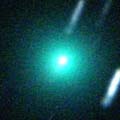
|
New comet discovered by the southern survey ASAS. It was 10.5 mag on Jan. 6 (John Drummond), but it brightened rapidly and reached to 7.2 mag now (Jan. 27, David Seargent). It will pass only 0.6 A.U. from the sun in late February. It will reach to 5 mag at maximum, brighter than the original prediction by 2 mag. In the Southern Hemisphere, it keeps observable until early March. But it will be very low, around 15 degree high, after late January. In the Northern Hemisphere, it will become observable in early March at 5.5 mag, and keeps observable in the morning sky while fading gradually. It will be visible visually until May.
Date(TT) R.A. (2000) Decl. Delta r Elong. m1 Best Time(A, h)
Jan. 28 20 38.58 -56 39.5 1.272 0.789 38 7.3 3:37 (334, 11)
Feb. 4 20 26.05 -51 39.9 1.163 0.691 36 6.6 3:47 (325, 13)
|
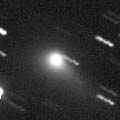
|
It was faint as 16.4 mag at the discovery in 2005 March (Mar. 12, R. H. McNaught). Then it brightened well as expected, and became visible visually as 12.2 mag in August (Aug. 3, Juan Jose Gonzalez). Now it is 9.9 mag (Jan. 21, Juan Jose Gonzalez). It was very small and sharp before, however, now it looks like a typical diffuse comet. It will reach to 10 mag from January to March. In the Southern Hemisphere, it is not observable until autumn. In the Northern Hemisphere, the altitude will be getting lower slowly after January, and it will be too low to observe in April.
Date(TT) R.A. (2000) Decl. Delta r Elong. m1 Best Time(A, h)
Jan. 28 22 58.73 -2 2.5 2.226 1.564 37 10.1 20:47 ( 86, -3)
Feb. 4 23 17.20 0 50.9 2.230 1.544 35 10.0 20:39 ( 88, -5)
|

|
It was expected to reach to 9 mag in spring. But actually, it is much fainer than expected, 13.9 mag on Aug. 1 and 11.7 mag still on Oct. 27 (Michael Mattiazzo). It seems to be a comet with very slow brightness evolution. It will be 11 mag at best. It is not observable until late March in the Northern Hemisphere, but will be observable for a long time while it is getting fainter after that. It will be too low even in the Southern Hemisphere from January to February. It was reported as 13.3 mag on Dec. 9 (Andrew Pearce). So maybe it is fading unexpectedly?
Date(TT) R.A. (2000) Decl. Delta r Elong. m1 Best Time(A, h)
Jan. 28 20 26.32 -42 17.1 2.456 1.609 24 11.4 3:37 (323, 2)
Feb. 4 20 28.49 -39 41.6 2.441 1.603 25 11.4 3:47 (316, 5)
|
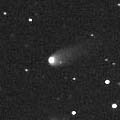
|
It brightened faster than a typical comet, and became visible visually as 13.5 mag in October (Oct. 24, Seiichi Yoshida). Now it is 13.2 mag (Dec. 22, Juan Jose Gonzalez). Small and strongly condensed. Because it is distant from the sun, it keeps observable at 13.5 mag in good condition for a long time until 2006 June.
Date(TT) R.A. (2000) Decl. Delta r Elong. m1 Best Time(A, h)
Jan. 28 10 5.00 52 40.2 4.409 5.220 141 13.5 1:38 (180, 2)
Feb. 4 10 1.54 53 1.0 4.403 5.215 141 13.5 1:07 (180, 2)
|

|
It had been so faint as around 15 mag for a long time since May. It had been too faint to see visually. However, an outburst occured on Sept. 9 and it brightened to 13 mag (Stephane Garro). Another outburst occured on Nov. 2, and it reached to 12.5 mag (Piotr Guzik). After that, it keeps somewhat faint around 14-15 mag. It was not visible visually on Jan. 18, fainter than 14.0 mag (Vitali Nevski). But another new outburst happened on Jan. 20. Now it is strongly condensed at 14.3 mag by CCD (Jan. 25, Toni Scarmato), and looks diffuse and bright as 13.6 mag visually (Jan. 26, Vitali Nevski).
Date(TT) R.A. (2000) Decl. Delta r Elong. m1 Best Time(A, h)
Jan. 28 1 49.87 21 21.6 5.781 5.785 85 13.5 20:47 (131, 15)
Feb. 4 1 52.75 21 25.4 5.893 5.786 78 13.6 20:39 (128, 12)
|
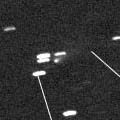
|
Recovered on Oct. 22 as 19.3 mag (C. W. Hergenrother). It will pass only 0.08 A.U. from the earth on May 12, remarkable approach after 76 years since its discovery in 1930. It was expected be so bright as 2 mag, but actually, it was fainter than its last appearance by 1.5 mag. Anyway, it will be 3.5 mag at best, and will be visible with naked eyes. It brightened up to 15.2 mag on Jan. 21 (Ken-ichi Kadota). It keeps observable in good condition all through the encounter in May. Brightening rapidly, and will be visible visually as 14 mag in late January. The component B (F) is fainter than this by 3 mag. The component E has not been recovered yet, which may have already disappeared because it faded before the perihelion passage in its last appearance in 2001. Due to the approach of the comet, Bootids meteor shower observed in 1930 may appear in outburst again in 2005 May and June. It will pass near by C/2004 K1 from Feb. 5 to 7.
Date(TT) R.A. (2000) Decl. Delta r Elong. m1 Best Time(A, h)
Jan. 28 13 14.17 10 29.8 1.295 1.917 113 14.6 3:37 (203, 42)
Feb. 4 13 23.89 10 42.5 1.170 1.852 118 14.2 3:47 (194, 43)
|
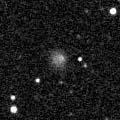
|
It had been an extremely faint Centaur asteroid until 2004, fainter than 21 mag. However, it brightened up to 17.5 mag on 2005 Dec. 30, and a coma was observed, then it was revealed to be a comet. It brightened furthermore, 14.8 mag on Jan. 7 (Ken-ichi Kadota). It is also visible visually at 14.4 mag (Jan. 8, Seiichi Yoshida). A strange spiral structure was captured like a planetary nebula. Looks diffuse visually. It seems to be a temporary brightening in outburst. Future brightness change is uncertain. It will pass the perihelion in 2015. The heliocentric distance reduces down to 5.9 A.U., and it will become brighter than now by 4 mag in calculation. However, the observations in its last return in 1980 were found and probably it was a faint asteroidal object at that time. Therefore, it will be back to the original brightness before 2015, and it will reach to 17 mag at best. Already it passed two weeks, but it is still bright as 14.7 mag on Jan. 24 (Ernesto Guido and Giovanni Sostero).
Date(TT) R.A. (2000) Decl. Delta r Elong. m1 Best Time(A, h)
Jan. 28 13 19.04 -6 26.7 12.697 13.021 107 14.4 3:37 (215, 57)
Feb. 4 13 18.83 -6 23.9 12.572 13.009 114 14.4 3:47 (199, 60)
|

|
Although it has already passed the perihelion in 2004 October, the fading after the perihelion passage is slow. It was visible visually still on Oct. 24 at 13.1 mag (Seiichi Yoshida). It is still bright, 14.4 mag on Dec. 17 (Ken-ichi Kadota). Because it is distant from the sun, it can be visible visually as 14 mag for a while after this.
Date(TT) R.A. (2000) Decl. Delta r Elong. m1 Best Time(A, h)
Jan. 28 2 25.92 -8 30.3 5.837 5.813 83 15.1 20:47 (114, 43)
Feb. 4 2 25.45 -7 53.3 6.016 5.877 77 15.2 20:39 (110, 38)
|
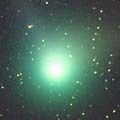
|
It was fantastic, so bright as 3.5 mag, so large as 30 arcmin, locating high overhead at its best time in early 2004 January. Then it had been getting fainter and smaller gradually, 12.5 mag on Sept. 3 (Edwin van Dijk) and 13.8 mag on Oct. 19 (Mitsunori Tsumura). It is appearing again in the morning sky. It was 15 mag on Dec. 27, as bright as expected (Syuji Kashiwagi). It was not visible visually, fainter than 13.9 mag (Jan. 8, Seiichi Yoshida).
Date(TT) R.A. (2000) Decl. Delta r Elong. m1 Best Time(A, h)
Jan. 28 16 47.75 -0 5.3 5.149 4.735 60 15.3 3:37 (259, 16)
Feb. 4 16 51.41 0 1.0 5.124 4.802 65 15.4 3:47 (253, 22)
|
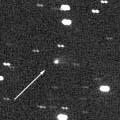
|
It will pass the perihelion soon, in 2006 February. But it did not brightened so much as expected, 15.7 mag on Dec. 18 (Ken-ichi Kadota). It keeps observable at 15-16 mag for a long time from 2005 spring to the end of 2006. Because it moves in the northern sky, it keeps observable for a long time in the Northern Hemisphere. It is brightest until May, but keeps lower than 30 deg high.
Date(TT) R.A. (2000) Decl. Delta r Elong. m1 Best Time(A, h)
Jan. 28 19 51.13 53 40.6 3.366 3.215 72 15.4 3:37 (226,-43)
Feb. 4 20 15.16 53 51.8 3.390 3.210 71 15.5 3:47 (226,-41)
|
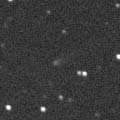
|
Although it was faint as 18 mag at the discovery in 2004 November, then it brightened very rapidly until early 2005, and reached to 16.0 mag on May 7 (Ken-ichi Kadota). After it appeared in the morning sky again, it continued brightening furthermore, and reached to 14.7 mag on Nov. 22 (Ken-ichi Kadota). It is also visible visually as 14.8 mag (Jan. 8, Seiichi Yoshida). After this, it keeps bright as 15 mag for a long time until spring. In the Northern Hemisphere, it keeps observable in good condition until summer when it becomes too faint.
Date(TT) R.A. (2000) Decl. Delta r Elong. m1 Best Time(A, h)
Jan. 28 13 59.58 12 5.4 2.232 2.641 103 15.5 3:37 (215, 36)
Feb. 4 14 3.74 12 17.5 2.175 2.664 109 15.5 3:47 (206, 39)
|
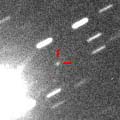
|
It was 18.2 mag on Dec. 24 (Ken-ichi Kadota), fainter than this ephemeris by 1 mag. However, it is getting brighter rapidly in the morning sky after this. It will become visible visually at 13 mag in March, and will reach to 11 mag in June. The condition is best beucase it is almost at opposition at the perihelion passage. However, it will be very low, only 13-20 deg high, from June to September in the Northern Hemisphere. When it gets higher again, it will be fainter than 14 mag, too faint to see visually.
Date(TT) R.A. (2000) Decl. Delta r Elong. m1 Best Time(A, h)
Jan. 28 15 17.61 -11 53.6 1.932 1.973 77 15.9 3:37 (254, 41)
Feb. 4 15 32.19 -12 58.2 1.827 1.937 81 15.6 3:47 (251, 46)
|
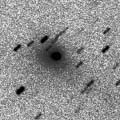
|
It has already gone far away, and it must have been around 19 mag in calculation. Actually, it was so faint as 18.3 mag on Jan. 8 (Ken-ichi Kadota). However, an unexpected outburst happened and it brightened up to 15.7 mag on Jan. 27 (Ken-ichi Kadota). Very strongly condensed with an almost stellar central condensation.
Date(TT) R.A. (2000) Decl. Delta r Elong. m1 Best Time(A, h)
Jan. 28 14 56.72 -8 56.5 3.108 3.152 83 15.7 3:37 (247, 43)
Feb. 4 15 0.79 -9 12.5 3.044 3.192 89 15.9 3:47 (239, 49)
|
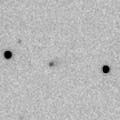
|
It brightened faster than a typical comet, and it reached to 16.1 mag on Dec. 13 (Ken-ichi Kadota). It will be observable in good condition as 16 mag for a long time until next spring.
Date(TT) R.A. (2000) Decl. Delta r Elong. m1 Best Time(A, h)
Jan. 28 10 56.56 65 37.8 4.312 4.976 127 15.9 2:29 (180,-11)
Feb. 4 10 53.16 66 13.8 4.316 4.975 127 15.9 1:58 (180,-11)
|
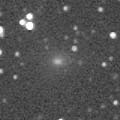
|
It reached to 11.4 mag in August (Aug. 12, Juan Jose Gonzalez). It was expected to start fading since early September. But actually, it keeps bright as 11.8 mag still on Oct. 7 (Juan Jose Gonzalez). Because it had been very low in the morning, it was not observed visually after that. Now it faded down to 16.2 mag (Jan. 11, Ken-ichi Kadota).
Date(TT) R.A. (2000) Decl. Delta r Elong. m1 Best Time(A, h)
Jan. 28 13 30.07 -6 38.3 2.140 2.570 104 16.2 3:37 (220, 55)
Feb. 4 13 25.39 -7 39.1 2.113 2.649 112 16.3 3:47 (203, 61)
|
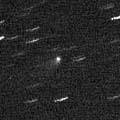
|
It was visible visually as 14.3 mag in 2005 spring (July 10, Edwin van Dijk). Although it has been not observable for a while, now it is appearing in the morning sky again. Now it is 16.7 mag (Dec. 18, Ken-ichi Kadota). Ken-ichi Kadota reported that a faint anti-tail is visible. It will be observable in good condition again in 2006 spring, but only 16 mag at best. Then it will fade out rapidly, and become fainter than 18 mag in July. It will pass near by the components C and B of 73P from Feb. 5 to 7.
Date(TT) R.A. (2000) Decl. Delta r Elong. m1 Best Time(A, h)
Jan. 28 13 37.37 10 1.2 3.476 3.897 108 16.4 3:37 (211, 40)
Feb. 4 13 29.52 11 3.4 3.382 3.928 116 16.4 3:47 (196, 43)
|
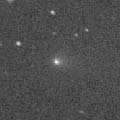
|
It was observed as 17.0 mag on July 10. Then it brightened as expected and reached to 15.0 mag on Oct. 1 (Mitsunori Tsumura). It was also visible visually as 13.5 mag Oct. 24 (Seiichi Yoshida). The second component was found at 18 mag on Nov. 30 about 20 arcmin from the main component. The main component also started fading, and it is 16 mag now.
Date(TT) R.A. (2000) Decl. Delta r Elong. m1 Best Time(A, h)
Jan. 28 1 26.51 3 48.6 2.449 2.368 73 16.4 20:47 (113, 23)
Feb. 4 1 37.53 5 4.5 2.534 2.377 69 16.5 20:39 (113, 21)
|

|
New comet. Almost stellar. It will be observable in good condition in February and March. It brightened up to 16.5 mag on Jan. 7 (Tsutomu Seki). Because it is brightening rapidly, it will reach to 16 mag. But it will fade out rapidly after that.
Date(TT) R.A. (2000) Decl. Delta r Elong. m1 Best Time(A, h)
Jan. 28 10 9.90 7 51.1 0.883 1.827 155 16.7 1:42 (180, 47)
Feb. 4 10 12.23 9 55.7 0.844 1.811 163 16.5 1:17 (180, 45)
|
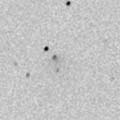
|
It passes the perihelion in 2006 February. But it is outside of Jupiter's orbit. So it keeps 17 mag for a long time. Because it moves in the northern sky, it keeps locating high and observable in good condition until 2006 summer.
Date(TT) R.A. (2000) Decl. Delta r Elong. m1 Best Time(A, h)
Jan. 28 15 33.64 66 5.9 6.532 6.797 101 16.7 3:37 (200,-19)
Feb. 4 15 34.46 66 35.3 6.514 6.797 102 16.7 3:47 (196,-17)
|

|
It was observed around 20 mag in early October, as bright as expected. Then it brightened rapidly and reached to 16.9 mag on Jan. 4 (S. Pastor, J. A. Reyes). It will be observable in good condition at around 17 mag from December to March.
Date(TT) R.A. (2000) Decl. Delta r Elong. m1 Best Time(A, h)
Jan. 28 11 15.08 -4 14.5 0.953 1.795 135 16.7 2:47 (180, 59)
Feb. 4 11 14.70 -5 11.2 0.924 1.808 142 16.8 2:20 (180, 60)
|
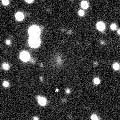
|
New comet. It must have been visible as bright as 16 mag in good condition in November and December. Now it is fading rapidly, 16.8 mag on Jan. 22 (Giovanni Sostero). It will be fainter than 18 mag in March.
Date(TT) R.A. (2000) Decl. Delta r Elong. m1 Best Time(A, h)
Jan. 28 5 46.76 18 55.7 1.212 2.058 138 16.9 21:16 (180, 36)
Feb. 4 5 48.45 17 53.6 1.287 2.080 132 17.0 20:50 (180, 37)
|
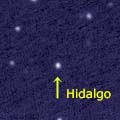
|
It reached to 13 mag and was observed visually in good condition in 2004 autumn. It has been not observable since August, but it is appearing at dawn again. It keeps 17 mag until late April. But it will go away soon after that. Next return is in 2018, when it will be 14.3 mag at best.
Date(TT) R.A. (2000) Decl. Delta r Elong. m1 Best Time(A, h)
Jan. 28 13 40.14 6 13.1 3.395 3.792 106 17.2 3:37 (213, 43)
Feb. 4 13 39.04 6 8.2 3.335 3.835 113 17.1 3:47 (201, 47)
|
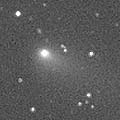
|
Although it was reported so faint as 17 mag at the discovery on Sept. 10 (M. E. Van Ness), it brightened rapidly and became so bright as 12.8 mag and visible visually in October (Oct. 24, Seiichi Yoshida). However, then it has been fading rapidly. It seems to have brightened temporarily in outburst. Now it faded down to 17-18 mag by CCD observations in January. Toni Scarmato reported it was 16.0 mag on Jan. 25, but extremely diffuse as DC=1.
Date(TT) R.A. (2000) Decl. Delta r Elong. m1 Best Time(A, h)
Jan. 28 1 58.22 23 12.9 2.983 3.106 87 17.1 20:47 (133, 15)
Feb. 4 2 5.00 23 23.2 3.107 3.132 82 17.4 20:39 (131, 13)
|

|
It reached to 17 mag in 2004 autumn. Although it has been not observable for a while, now it is observable as 17 mag in good condition again. It was reported as 18 mag recently, fainter than this ephemeris by about 1 mag.
Date(TT) R.A. (2000) Decl. Delta r Elong. m1 Best Time(A, h)
Jan. 28 7 21.20 16 25.7 2.360 3.306 160 17.2 22:50 (180, 39)
Feb. 4 7 17.19 16 33.6 2.410 3.319 153 17.2 22:18 (180, 38)
|
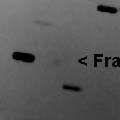
|
One of the split components born in outburst in 1995. Recovered on Jan. 6 as 19 mag. It keeps the same brightness as in its previous appearance in 2001. It will pass only 0.067 A.U. from the earth on May 14, remarkable approach after 76 years since its discovery in 1930. It is fainter than the main component by 3 mag, but will be closer to the earth than the main component. It will reach to 6 mag, and double naked eye comets will be visible. It brightened up to 17.8 mag on Jan. 23 (Ken-ichi Kadota). It keeps observable in good condition all through the encounter in May. It will pass near by C/2004 K1 from Feb. 5 to 7.
Date(TT) R.A. (2000) Decl. Delta r Elong. m1 Best Time(A, h)
Jan. 28 13 11.92 10 47.4 1.298 1.926 114 17.7 3:37 (202, 42)
Feb. 4 13 21.34 11 2.4 1.173 1.861 118 17.2 3:47 (193, 43)
|

|
It will reach to 15.5 mag from late 2006 to early 2007 although locating rather low. It is observable around 17 mag from this winter to spring. It was observed as around 17.5 mag in early January.
Date(TT) R.A. (2000) Decl. Delta r Elong. m1 Best Time(A, h)
Jan. 28 10 0.79 -8 46.9 4.324 5.174 146 17.3 1:34 (180, 64)
Feb. 4 9 51.76 -8 53.2 4.241 5.137 152 17.2 0:57 (180, 64)
|

|
Although it was so faint as 18.5 mag at the discovery in September, it brightened rapidly. It reached to 16.4 mag on Nov. 27 (Yuji Ohshima). It will be observable around 17 mag until March.
Date(TT) R.A. (2000) Decl. Delta r Elong. m1 Best Time(A, h)
Jan. 28 3 13.26 18 38.2 4.884 5.197 103 17.3 20:47 (146, 29)
Feb. 4 3 8.73 18 33.8 5.016 5.194 94 17.3 20:39 (140, 26)
|

|
It was observed as 17.6 mag on Jan. 3 (Ken-ichi Kadota). It will be observable at 18 mag in good condition until May.
Date(TT) R.A. (2000) Decl. Delta r Elong. m1 Best Time(A, h)
Jan. 28 15 18.81 59 56.5 4.681 4.966 101 17.5 3:37 (203,-13)
Feb. 4 15 14.21 61 46.5 4.635 4.964 103 17.5 3:47 (197,-11)
|
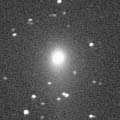
|
It was 17.3 mag on Nov. 1 (Ken-ichi Kadota), fading slowly as expected. It will be fainter than 18 mag in March. It keeps locating high.
Date(TT) R.A. (2000) Decl. Delta r Elong. m1 Best Time(A, h)
Jan. 28 13 30.48 37 27.7 4.386 4.882 114 17.6 3:37 (198, 15)
Feb. 4 13 28.02 38 3.6 4.375 4.940 119 17.6 3:47 (189, 16)
|
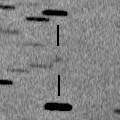
|
It was recovered at 17.3 mag on Sept. 7 (Filip Fratev), as bright as exepcted. It will be fainter than 18 mag in February.
Date(TT) R.A. (2000) Decl. Delta r Elong. m1 Best Time(A, h)
Jan. 28 12 21.31 27 49.6 1.412 2.170 128 17.8 3:37 (184, 27)
Feb. 4 12 21.70 29 35.7 1.402 2.205 134 17.9 3:26 (180, 25)
|

|
New faint comet. It will be only 18 mag at best in December and January. However, Yuji Ohshima reported it was bright as 16.5 mag on Nov. 27, much brighter than this ephemeris.
Date(TT) R.A. (2000) Decl. Delta r Elong. m1 Best Time(A, h)
Jan. 28 3 36.97 32 46.9 2.883 3.368 111 17.9 20:47 (158, 18)
Feb. 4 3 41.29 32 32.5 2.963 3.360 105 17.9 20:39 (155, 17)
|
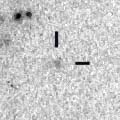
|
It is observable at 17.7 mag in 2006 spring. It is also observable at 17.5 mag in 2007 spring, but the altitude will be a bit lower.
Date(TT) R.A. (2000) Decl. Delta r Elong. m1 Best Time(A, h)
Jan. 28 11 39.40 6 5.5 4.153 4.897 134 17.9 3:12 (180, 49)
Feb. 4 11 37.79 6 17.1 4.073 4.891 142 17.9 2:43 (180, 49)
|
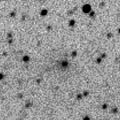
|
It was observed as 17.7 mag in November at opposition (Nov. 3, Ken-ichi Kadota). It will be fainter than 18 mag in February. However, it will be observable at 18 mag again one year later, in next spring.
Date(TT) R.A. (2000) Decl. Delta r Elong. m1 Best Time(A, h)
Jan. 28 3 22.34 17 45.6 4.249 4.602 104 17.9 20:47 (148, 31)
Feb. 4 3 23.35 17 57.4 4.366 4.610 98 18.0 20:39 (143, 28)
|
|
![]()
 C/2002 VQ94 ( LINEAR )
C/2002 VQ94 ( LINEAR ) 60P/Tsuchinshan 2
60P/Tsuchinshan 2 P/2005 YQ127 ( LINEAR )
P/2005 YQ127 ( LINEAR ) (944) Hidalgo
(944) Hidalgo P/2005 R2 ( Van Ness )
P/2005 R2 ( Van Ness ) 119P/Parker-Hartley
119P/Parker-Hartley 73P-B/Schwassmann-Wachmann 3
73P-B/Schwassmann-Wachmann 3 C/2005 EL173 ( LONEOS )
C/2005 EL173 ( LONEOS ) C/2005 R4 ( LINEAR )
C/2005 R4 ( LINEAR ) C/2005 G1 ( LINEAR )
C/2005 G1 ( LINEAR ) C/2004 Q1 ( Tucker )
C/2004 Q1 ( Tucker ) 171P/2005 R3 ( Spahr )
171P/2005 R3 ( Spahr ) C/2005 W2 ( Christensen )
C/2005 W2 ( Christensen ) 99P/Kowal 1
99P/Kowal 1 65P/Gunn
65P/Gunn![]()


























